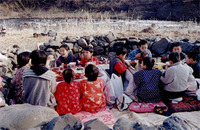

Total:35items
- Folk Performing Art (16)
- Kenbai: Sword Dance
- Kirin Shishimai: Kylin Lion Dance
- Yoshiwa Taiko Odori: Yoshiwa Drum Dance
- Omiya Odori: Omiya Dance
- Tsurusaki-Odori festival
- Omi Take-no-karakai (Tug-of-wars with bamboo)
- Nakizumo: Crying Baby Sumo
- Ryugasaki Tsukumai:Ryugasaki Acrobatic Performance
- Mikawa Manzai
- Esashi Oiwake: Esashi Folk Singing
- Ayado Yonenbutsu and Bon festival dance
- Occhi-no-Ohinagayu (rice porridge offering for the Doll's Festival in Occhi)
- Hanatori-odori Dance (Masuda area)
- Kaga-manzai
- Rice Planting festival of Tsutsukowake Shrine
- Edo sato kagura: Edo folk dance for entertaining god
- Kabuki (2)
- Noh & Kyogen (1)
- Festival (10)
- Ritual & Ceremony (2)
- Puppet Play (2)
- Folk technology (2)

 |
|
《Feature》
Occhi-no-Ohinagayu, a rice-porridge offering event is a folk event which has been passed down by children over years. Although this event used to take place in a few other villages as well until the early Showa Period (20c), Occhi is the only region where the event has been handed down until today.
Although when the "Ohina-gayu" event started is unknown, the elderly say that they experienced the event in their childhood. As they say that the event had been enjoyed even before their birth, it must have been passed down since long time ago.
The "Ohina-gayu" is said to have originated in a story of a princess who reached the riverbank exhausted after being washed away in a river long ago. People cared for the princess and offered her rice porridge. In the event, however, the castle entrance is faced toward the Tenjin Shrine on a hilltop in the north of the village and dolls modeled after Tenjin (the god of learning) are displayed. Considering these features, the event could also mean a prayer for children's successful academic development even with its uncertain origin. Setting the origin of the event aside, it is believed that various local customs and the trend of the times have brought wide-ranging implications of the event in the present style.
In those days without televisions and video games, children usually enjoyed playing outside together. "Ohina-gayu" has been a part of children's outdoor plays. In March, after enduring the cold winter, children make teams by about 10 to prepare for "Ohina-gayu." Each team gathers along the Kanna River respectively and team members cooperate to pile up stones to build round-shaped walls called 'castle'. When there were many children, as many as 7 or 8 castles were created by children alone. However, the number of children has declined and only a couple of castles are created today even with adults' help.
At dawn on April 3rd, a month later of the usual Doll's Festival, hina dolls (special dolls displayed for the Dolls' Festival), kotatsu (low table with a heater underneath and covered with a quilt), karuta (traditional Japanese playing cards), and other cards as well as side dishes are carried into the castles. The hina dolls are displayed in the innermost place of the castle, facing toward Tenjin on the hill on the opposite shore. Until the mid-Showa period, clay dolls modeled after the sitting Tenjin used to be displayed, but dolls modeled after sitting court ladies are used instead recently. Children build a furnace with stones, put dry branches into it, and cook rice porridge in a pot to offer it the hina dolls. Children also enjoy breakfast with the dolls. After breakfast, they clear off the table and have fun together playing karuta, cards, or quiz and stay in the castle the whole day.
[National Selected Intangible Folk Cultural Properties]
Provided by: Ueno-mura Commerce and Industry Association
Translation by: Tomoko Yamamoto, reviewed by Marie Mine
Occhi-no-Ohinagayu, a rice-porridge offering event is a folk event which has been passed down by children over years. Although this event used to take place in a few other villages as well until the early Showa Period (20c), Occhi is the only region where the event has been handed down until today.
Although when the "Ohina-gayu" event started is unknown, the elderly say that they experienced the event in their childhood. As they say that the event had been enjoyed even before their birth, it must have been passed down since long time ago.
The "Ohina-gayu" is said to have originated in a story of a princess who reached the riverbank exhausted after being washed away in a river long ago. People cared for the princess and offered her rice porridge. In the event, however, the castle entrance is faced toward the Tenjin Shrine on a hilltop in the north of the village and dolls modeled after Tenjin (the god of learning) are displayed. Considering these features, the event could also mean a prayer for children's successful academic development even with its uncertain origin. Setting the origin of the event aside, it is believed that various local customs and the trend of the times have brought wide-ranging implications of the event in the present style.
In those days without televisions and video games, children usually enjoyed playing outside together. "Ohina-gayu" has been a part of children's outdoor plays. In March, after enduring the cold winter, children make teams by about 10 to prepare for "Ohina-gayu." Each team gathers along the Kanna River respectively and team members cooperate to pile up stones to build round-shaped walls called 'castle'. When there were many children, as many as 7 or 8 castles were created by children alone. However, the number of children has declined and only a couple of castles are created today even with adults' help.
At dawn on April 3rd, a month later of the usual Doll's Festival, hina dolls (special dolls displayed for the Dolls' Festival), kotatsu (low table with a heater underneath and covered with a quilt), karuta (traditional Japanese playing cards), and other cards as well as side dishes are carried into the castles. The hina dolls are displayed in the innermost place of the castle, facing toward Tenjin on the hill on the opposite shore. Until the mid-Showa period, clay dolls modeled after the sitting Tenjin used to be displayed, but dolls modeled after sitting court ladies are used instead recently. Children build a furnace with stones, put dry branches into it, and cook rice porridge in a pot to offer it the hina dolls. Children also enjoy breakfast with the dolls. After breakfast, they clear off the table and have fun together playing karuta, cards, or quiz and stay in the castle the whole day.
[National Selected Intangible Folk Cultural Properties]
Provided by: Ueno-mura Commerce and Industry Association
Translation by: Tomoko Yamamoto, reviewed by Marie Mine
| City/Town | Occhi, Ueno-mura, Tano-gun, Gunma Prefecture |
|---|---|
| Location | Occhi, Ueno-mura, Tano-gun, Gunma Prefecture
Date: April 3rd, every year |
| Contact | Ueno-mura Commerce and Industry Association
Tel: +81-(0)274-59-2254 (Japanese only) |
| Highlight/POI | We hardly see children playing outside today. Such nostalgic scene and the event in the season which harbingers the arrival of spring may remind you of Japan's good old days. Seeing children playing happily around kotatsu will also definitely delight you.
Assistance needed? For inquiries in English: JTCO Contact Form Your inquiries will be forwarded by JTCO in Japanese to the organization you wish to contact. |



